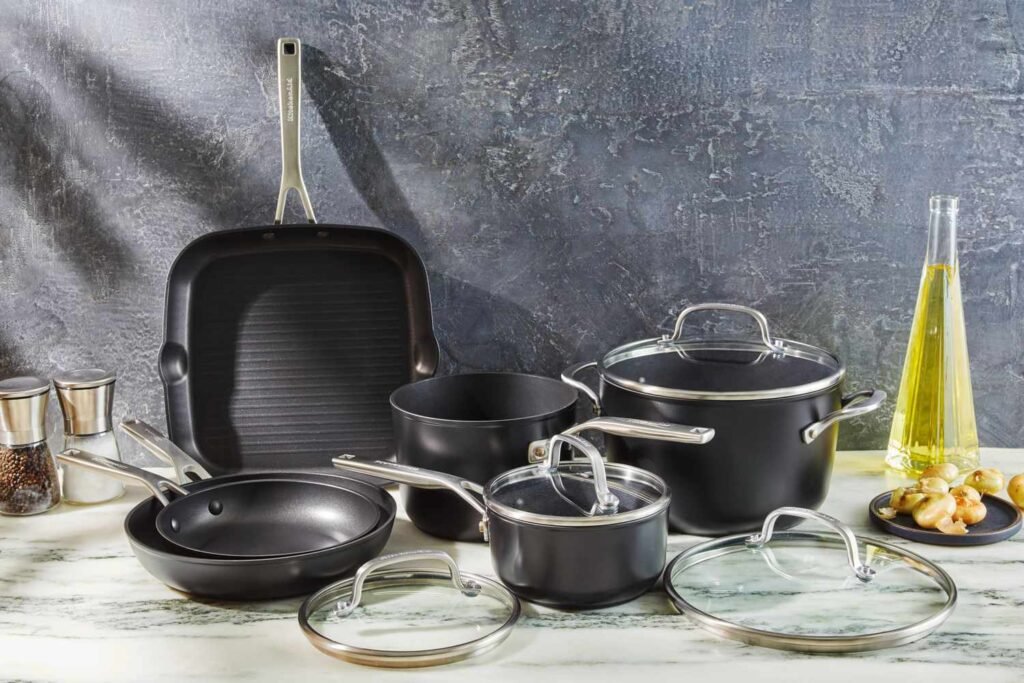
HexClad cookware markets itself as a “hybrid” pan that blends stainless steel, ceramic-style nonstick, and cast-iron durability. Its honeycomb‑patterned surface and high price point promise a best-of-both-worlds tool for everyday cooking. But after testing and extensive usage, the reality is more nuanced than the marketing suggests.
What Experts Say: Performance Under Scrutiny
Wired found that HexClad pans underperformed compared to All‑Clad’s stainless-steel staples. Though easy to clean and oven-safe up to 500 °F, the hybrid surface still required oil or butter for most cooking tasks. The curvy handle was difficult to grip, and overall, the cookware didn’t justify its cost or live up to its claims of combining nonstick and stainless performance .
Serious Eats spent a month testing the 12-inch Hybrid Pan and noted it was durable—one staffer has used hers since 2016 without damage. Still, they concluded you’d be better off purchasing both a stainless steel skillet and a nonstick pan separately, since HexClad’s hybrid design sacrifices the strengths of each .
Real-World & Community Feedback
Homes & Gardens reviewer praised HexClad’s nonstick surface, calling it “hands-down the best I’ve used” for eggs, tofu, and halloumi. The pan is induction-compatible, lightweight, and easy to clean—but it’s not heirloom quality, and the price is steep unless bought on sale.
LeafScore noted that HexClad recently removed PTFE from its coating and switched to a ceramic alternative. While the pans are well-made with solid three-ply construction, LeafScore remains cautious about recommending them given the high price and limited toxicity testing .
Reddit users offered both praise and skepticism:
“Nothing sticks to them… they heat quickly and stay hot”
…but others questioned their value, saying HexClad “sells for just a tick below luxury brands while delivering similar quality to mid-priced DTC cookware” .
Pros & Cons at a Glance
Pros
- Exceptional initial nonstick release for eggs and delicate foods
- Induction-ready, fast heat-up, and oven-safe to 500 °F
- Easy cleanup—dishwasher-safe
- Lifetime warranty and solid construction, resistant to scratching
Cons
- Hybrid design compromises true searing ability and reliability
- Still requires oil for release; not genuinely nonstick
- Specialty surface may wear over time
- Curvy handle is uncomfortable and possibly unsafe under heat
- Cost is high—often comparable to buying separate stainless and nonstick sets
- Brand marketing faced legal scrutiny: HexClad settled a lawsuit over “non‑toxic” claims in 2025. Should You Buy It?
If you prioritize effortless release and one-pan convenience—and do not mind paying for it—HexClad can deliver. Its cooking ease for eggs, tofu, and simple meals is real and compelling.
That said, if your palette leans toward high-heat searing, long-term durability, or technique-driven performance, traditional cookware like stainless steel, carbon steel, or cast iron offers clearer value—and often better performance over time.
Final Thought
HexClad cookware delivers a usable hybrid surface that makes cooking eggs and delicate foods simple—but it’s neither the best nonstick nor the best stainless pan by itself. With careful handling, it can serve well for specific purposes. But for long-term effectiveness, versatility, and true performance, pairing a proven stainless skillet with a reliable nonstick pan may offer better cooking results—and better value.
